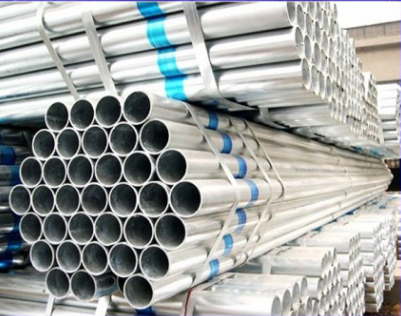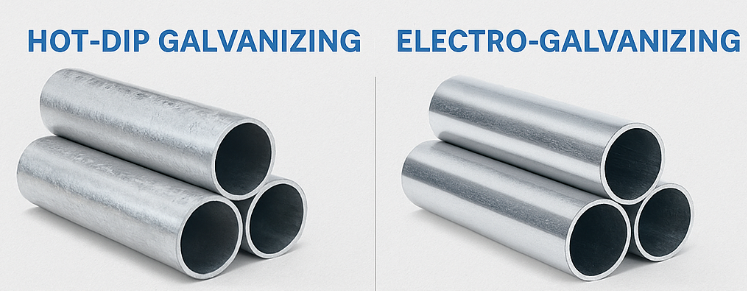In industries such as construction, plumbing, HVAC, telecommunications, power, and agricultural facilities, steel pipes are indispensable as foundational materials. Among the various types of steel pipes available, galvanized steel pipes have long held a prominent position in the market due to their excellent corrosion resistance and superior mechanical strength. This article will delve into the construction, performance, classification, application scenarios, and comparisons with other materials of galvanized steel pipes from a “material properties” perspective, helping purchasers and engineering users make more informed decisions when selecting galvanized steel pipe products.

1.What are galvanized steel pipes?
Galvanized steel pipes (Galvanized Steel Pipe) refer to steel pipes with a layer of zinc coating applied to their surfaces to enhance corrosion resistance. In simple terms, a “protective layer” of zinc is added to the outer surface of carbon steel pipes to prevent rusting or corrosion in humid or corrosive environments.
Galvanized steel pipes have the following characteristics:
Corrosion resistance: The zinc layer effectively blocks air and moisture, preventing the steel from rusting
High durability: Especially hot-dip galvanized steel pipes, which have a service life of 20–50 years
Structural strength: Retains the strength and load-bearing performance of steel
Wide application: Used in water supply, scaffolding, fencing, communications, power, agriculture, and other fields
2. Common classifications of galvanized steel pipes:
Classification by galvanizing process

| Type | Process characteristics | Application scenarios |
| Hot-dip galvanized steel pipes | The steel pipes are immersed in molten zinc, resulting in a thick zinc layer with strong adhesion | Outdoor structures, scaffolding, sprinkler system supports |
| Electrogalvanized steel pipes | Zinc layer deposited via electrolysis, thin zinc layer with a bright surface | Indoor conduit, furniture, lighting fixtures |
Classification by pipe shape
| Type | Characteristics |
| Round galvanized steel pipes | Most widely used, commonly applied in water supply, structural supports, scaffolding, etc. |
| Square galvanized steel pipes | Commonly used for door and window frames, fences, guardrails, and architectural decorations |
| Rectangular galvanized steel pipes | With varying length-to-width ratios, suitable for lightweight structural supports, greenhouse frames, and other special-shaped projects |
Classified by wall thickness grade
| Type | Description |
| Thin-walled galvanized steel pipes | Wall thickness typically < 2.0mm, lightweight, cost-effective, easy to process, suitable for non-load-bearing structures |
| Medium-wall galvanized steel pipes | Commonly used for structural supports, guardrails, and scaffolding, balancing strength and cost |
| Thick-wall galvanized steel pipes | Wall thickness typically ≥ 4.0mm, high pressure resistance and impact resistance, used for heavy-duty structures |
Classified by application or function
| Classification name | Typical applications |
| Structural galvanized steel pipes | Used for load-bearing structures such as supports, scaffolding, and sheds |
| Galvanized steel pipes for conveyance | Used for conveying water, gas, oil, and other media, commonly found in water supply and drainage systems |
| Galvanized steel pipes for decoration | Used in furniture, guardrails, display racks, and other applications with high aesthetic requirements |
| Galvanized pipes for agricultural/photovoltaic use | Used for greenhouse frames, photovoltaic supports, etc., emphasizing weather resistance and strength |
Classified by joint type
| Type | Characteristics |
| Welded galvanized steel pipes | Common in hot-dip galvanized products, formed first, then welded and galvanized, low cost, high production efficiency |
| Seamless galvanized steel pipes | Rare, seamless steel pipes are produced first, then galvanized, high cost, used in high-pressure systems or special requirements |
3. Composition of galvanized steel pipes
Galvanized steel pipe = carbon steel base pipe + zinc coating
Carbon steel base: Provides strength, pressure resistance, and structural stability;
Zinc coating: Applied to the steel surface via hot-dip or electroplating processes, forming a physical barrier while providing electrochemical protection (sacrificial anode effect), significantly extending the service life of the steel pipe.
The performance advantages of galvanized steel pipes stem from the synergistic interaction between the base material and the protective layer.
Internal base material — carbon steel pipe
High yield strength
Good weldability
Easy to process by bending/cutting
External coating — metallic zinc protective layer
Resists oxidation and acid-alkali corrosion
Prevents steel rusting and perforation
Extends service life by 10–20 years or more
4.Key Performance Analysis
| Performance Type | Description |
| Corrosion Resistance | Zinc layer protection and electrochemical anodic effect, strong resistance to oxidation and water erosion |
| Structural Strength | Carbon steel base material, strong pressure and load-bearing capacity |
| Impact Resistance | Hot-dip galvanized layer is tightly bonded, unlikely to peel off or damage |
| Processability | Weldable, bendable, and drillable (Requires proper process coordination) |
| Service Life | Hot-dip galvanizing can last over 20 years, while electrogalvanizing varies from 5 to 10 years |
| Cost-Effectiveness | Lower cost than stainless steel pipes, offering high cost-effectiveness |
5. Hot-Dip Galvanizing vs. Electrogalvanizing: Material Property Comparison
| Item | Hot-dip galvanizing | Electrogalvanizing |
| Zinc layer structure | Zn-Fe alloy layer and pure zinc layer, metallurgical bonding | Single zinc layer, physically adhered |
| Adhesion strength | Extremely strong, unlikely to peel off | Weaker, prone to damage from friction or processing |
| Zinc layer thickness | Thick (60–120 μm) | Thin (5–15 μm) |
| Corrosion Resistance | Extremely strong, suitable for outdoor and harsh environments | Moderate, suitable for dry or indoor environments |
| Surface Finish | Slightly rough, grayish | Smooth and bright, silver-white |
| Impact Resistance | High, good structural strength | Low, prone to scratches exposing the base material |
Galvanized steel pipes are structural and conveying materials that achieve high strength, durability, and cost-effectiveness through scientific metal coating. It combines the strength of carbon steel with the corrosion resistance of the zinc coating, with both properties complementing each other, making it highly favored in engineering applications. For purchasers, a thorough understanding of its material properties can help select more suitable product types and processing methods, thereby achieving the project’s goals of durability, safety, and cost-effectiveness in material selection.
